Roger J. Wendell
Defending 3.8 Billion Years of Organic EvolutionSM


Me at NMC6 (Group Station Monterey) in 1977 after having served two years at NMO
[This particular room at NMC6 was a special favorite of the local TV news station
whenever there was an active SAR (Search and Rescue) operation underway...]

|
Click Here for notes, stories and thoughts from "Coasties" who stopped by this page! |

|
Click Here for Coast Guard Photos and Friends! |
In my late teens and early 20s I was a Radioman (RM2) at three U.S. Coast Guard facilities:
NMO - ComSta Honolulu, Hawai'i (Wahiawa, O'ahu 1975-77) [RMIC Ted Burke and RMIC Paul Vanderslice]
NMC6 - Group Station Monterey, California (Monterey, CA 1977-79) [RMIC Jim Watson]
NMC - ComSta San Francisco, California (Pt. Reyes, CA 1981 Reserve Duty)
:
|
|
Click Here for Radio KNUS' Randy Corporon mentioning me, the Coast Guard, NMO, NMC, and NMC6 on Memorial Day! |
:
My boot camp experience took place in 1975 with Company Alpha 100 at Government Island, Alameda, California. That same year I completed 5 months of Radioman "A" School in Class RMA-20-11-75 a few miles further up north in Petaluma, California. While at RM School I also broke, and currently hold, the Coast Guard's Morse code receive record at 40 WPM at 99%+ accuracy.

Veterans Day
In the United States, Veterans Day was originally called Armistice Day, commemorating the signing of the agreement that ended World War I at 11:00 A.M., November 11, 1918. President Woodrow Wilson celebrated the first Armistice Day in 1919. Since then, Veterans Day has always taken place on the 11th of November each year. Memorial Day is the holiday set aside to pay tribute to those who died serving in the military and is celebrated the last Monday in May each year.

NMC6 in 1977:
 Roger J. Wendell, age 19, at Radioman A School Petaluma, California - 1975 |
The photo at left was taken in 1975 when I was 19, the one to the right at age 21 in 1977. The picture at left at Radioman "A" School in Petaluma, California. The photograph at the right is outside Monterey Group Station (California) looking in through the fence. It was taken i October of that year. |
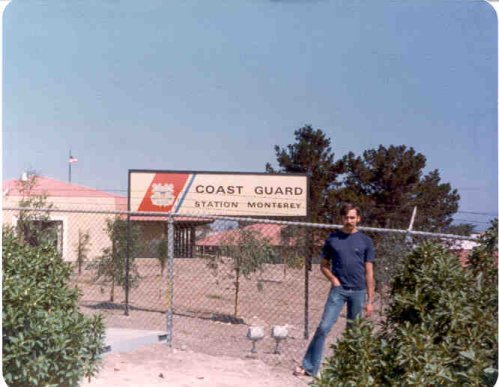 Me, again, at NMC6 in 1977 |
NMC6 in 2007:
30 Years later I stopped by Monterey to take a quick look around in March, 2007. I stopped by again, that November, and took another look around!
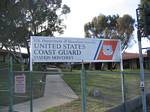 NMC6 |
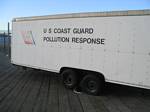 Pollution Response |
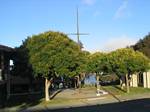 Flagpole at main entrance |
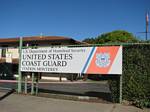 Again in November... |
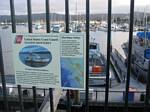 USCG Pier |
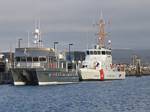 NOAA & Cutter Hawksbill |

|
Click Here for a list of ET duties from David Ingebright from when he was stationed there from 1972 to 1976! |
|
"HI roger: are you on pike's peak yet? Attached, here's a start of the rundown you suggested. I can fill it in and make a story or we can leave it here. Man, that was a lot of equipment to keep running. The worst were the LF radiobeacons. Xmitted all on the same freq like 386Kc. Eacho one xmitted on a different minute out of five. Clocks were GSA issue grandfather clocks... you can imagine listening to WWV and trying to get the clocks to keep time within a few seconds in a drafty solid-rock quarried lighthouse..." //dave |



Here's me standing in front of the school. At the time (early July '75) I was 19 and about to set the school CW record for 5 character coded groups (40+ wpm). During RM School I was still WBØJNR - my KH6JDO call was assigned when I reached Hawai'i a few months later.
Coast Guard Class RMA 20-11-75
TRACEN Petaluma, California, September 19, 1975

Here are everyone's name and initial assignment,
Left to Right, as best that I remember:
- Back Row:
Rick Beatty (USCGC Dauntless), Mellerup (Group Woods Hole), Harmon, John Barnwell (Group Astoria), Roger J. Wendell (CommSta Honolulu), Coyne (USCGC Vigilant)
- 2nd Row from Back:
P.E. Williams (USCGC Chase), Mark Carter (RadSta Miami), Mason (CommSta Kodiak), Mike Bell (USCGC Mellon), Kathy Taylor (CommSta Boston)
- 2nd Row from Front:
Class Leader F.P. Williams (RadSta Miami), Class Advisor RM2 Norm Wolf, Carlisle (Group Shinecock), Art Femister (USCGC Venturous), Miller (USCGC Campbell).
- Front Row:
Alario (USCGC Bibb), Turner (Group Coos Bay), Wayne Porter (Group Chincoteague), Pete Golfetto (USCGC Dallas).
"Through These Doors Pass The Nation's Best Military Radiomen" (sign in 3rd photo, below)
These old photos were taken by me, at age 19, with a very primative camera from that era. The sign
above my head, in the third photo from the left, was somewhat famous as it said, "Through These Doors
Pass the Nation's Best Military Radiomen" - over the years I've had various radio ops ask me about that
sign even though they'd never been there or seen a picture of it! (word certainly got around back then!)
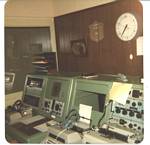 "The Cage" |
 Me in Phase 5 Net |
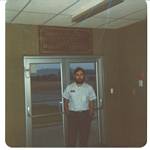 "Through These Doors..." |
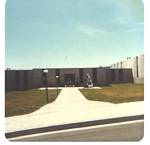 Stedman Hall |
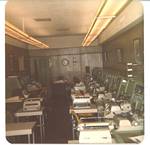 Net |
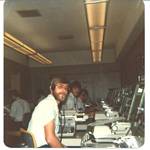 Larry Mason, John Barnwell, and Mike Bell |
"Through These Doors..." Photo Update!
August 22, 2017


|
Click Here for my Hawai'i Page! |
NMO - Wahiawa, O'ahu, Hawai'i
(My first Coast Guard communications assignment mixed with a bit of service for the Navy!)
KW7
Click Here for a descriptionI was assigned to NMO (US Coast Guard Communications Station Honolulu located in Wahiawa on the Navy's NAVCAMS EASTPAC base) from 1975 through 1977. It was a pretty exciting assignment for a young guy as keenly interested in Morse code and communications as I was! At NMO I gained all kinds of experience with MF, HF, VHF military and maritime communications. We used Model 28 teletype machines, KW-7 (code name "Orestes") crypto systems, and Collins 651s1 general coverage receivers - all pretty much state-of-the-art at that time! The KW-7 was an on-line, send/receive crypto unit installed in shore stations and aboard ships to create secure communications networks, when needed. Each radio day (0000 zulu, or UTC) we changed a special "IBM-like" card that provided necessary code information for the next 24 hours. If I recall, correctly, prior to the card we also used a plug-board where the newest members of the team were awarded the tedious duty of switching little wires around for that day's code. I wish I had photos of all this but, at the time, it was all classified so things like that were kept out of any photographs for obvious reasons!
Anyway, at NMO I kept busy with all kinds of antenna switching, log keeping, message handling, weather observations, teletype (My typing speed was well over 70 wpm but had some peculiarities like the required hitting of "carriage return," twice," to ensure proper line advancement, etc.), VHF and HF marine and weather broadcasts. Also, it was sometime around 1976 that I was made supervisor of a small unit that had the communications responsibility for two conventionally powered naval submarines.These two submarines were probably the last of the navy's conventionally powered fleet and were assigned to NMO because of our communications expertise and physical location on their base (see NAVCAMS EASTPAC description next paragraph below). I remember we sent all of the submarines' traffic, both plain text and encrypted, into the "blue" each day, at a predetermined time with an exact repeat of the broadcast a dozen or so hours later. Then, at week's end, the submarines would surface antennas and send us a long list of the messages that they had received in their entirety. Anything that was missing, of course, was then sent by us again, twice, the following day after the submarines had submerged again. The Coast Guard always had a willingness to take on extra responsibilities and duties but to the best of my knowledge communicating with submarines was one of its more unusual activities!
To reach NMO you had to drive through Whitmore Village, near the town of Wahiawa (located in the center of O'ahu) and onto NAVCAMS EASTPAC - the Naval communications facility where NMO was physically located. At the time, even back then, security was relatively "tight" with Marines guarding not only the parameter and vehicle entrances but some of the various facilities inside the base as well. One time, unfortunately, I was held lying on the ground, spread-eagle, with a gun (I believe it was .45) to my head after wandering back onto the base from an adjacent mountainside where a friend and I had just climbed (a large portion of the the Hawaiian islands, at that time, was held/owned by the U.S. government so if you wanted to to do a lot of hiking or climbing you usually found yourself trespassing...). Anyway, I obviously survived that little incident but learned, 30 years later, that security was even more strict than I could ever have imagined. My wife and I attempted visiting the base, during a trip to Hawai'i in '07, only to find a very menacing display of guns and bravado at the main gate that quickly turned us around. Oh well...

|
Click Here for some detailed radio club history about KH6UL at NAVCAMS EASTPAC! |
Voice Distress guarding 2182 KHz and 156.8 MHz FM
AMVER 12 & 16 MHz AMVER position at NMO
NMO circa 1976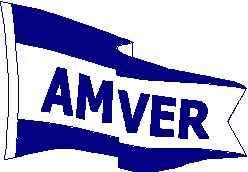
AMVER stands for "Automated Mutual Assistance Vessel Rescue" system and is a Coast Guard supported world-wide maritime safety network. A great many AMVER messages were "worked" at this NMO position. Note the ubiquitous Collins 651S1 receiver...
Ship to Shore guarding 6521.8 and 13.144 MHz.
|
|
Click Here to download and hear a 4mb MP3 audio clip about a Coast Guard "iron turnings" rescue mission I
was involved in. This clip is from a commercial radio station broadcast on September 1st, 2001. Boulder, Colorado station KVCU (1190 AM) interviewed various members of the Colorado QRP Club and broadcast our
stories on their Saturday Morning "Hangover brunch" program... (Click Here for the 21 mb wav file) |
NMO Barracks Life:
Since NMO was a "tenant" command at NAVCAMS EASTPAC (a Navy communications base) I lived in the barracks along with all of the other single personnel. Barracks life, like the college dorm experience, probably isn't interesting to anybody but those who actually experienced it. Nevertheless, I include these few shots for not only historical purposes, but because the classified nature of our NMO mission didn't allow too many photographs were I worked!These barracks probably aren't what you would have envisioned for a bunch of enlisted guys. I'll have to admit these were a huge step up from where we lived during boot camp and technical training (these particular barracks housed not only Coast Guard radiomen but Navy electronics technicians and "CTs" - communications and linguistic experts. So, since all of us were skilled petty officers the accommodations were a bit nicer but still pretty crummy by civilian standards (common showers, noisy conditions, etc.). Nevertheless, we had a lot of fun there - just like any college dorm!
As I mentioned above, most of my barracks neighbors were "CT's" - Communications Technicians mostly involved in collecting and analyzing intelligence. Within the CT ranks, back then, there were a variety of subdisciplines related to radio ("R Branchers"), crypto ("C"), maintenance ("M"), etc. The R brancers did the actual radio intercept work while another subdiscipline was involved with linguistics. During my time at NMO I was studying Russian language, part-time, at the University of Hawaii, and would often attempt to practice my new skills with the many CT's on the base. For obvious reasons security personnel eventually discouraged me from pursuing those kinds of study methods...
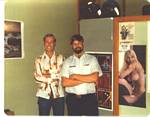 1. Tom Volkanant & Dan Mullins |
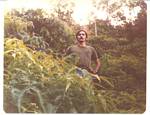 2. Roger stoic in the Rainforest |
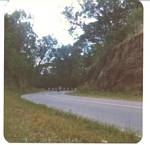 3. Base road & my Honda |
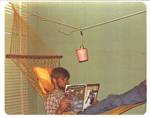 4. Kent Brown |
 5. Getting ready for radio watch... |
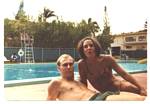 6. Tom Volkanant and Lynn Lacey |
Some explainin'
- Ahhhhh..... Maybe that very "distinctive" poster caught your eye in the first photo? Well, I thought long and hard (actually, I spent about 75 seconds on the "problem...") about covering it up, a bit, before posting it here, and then thought better of it. Why, you might ask? Well, times have certainly changed in the 31+ years since I got around to scanning these photos for posting here. Back then, such displays were permissible in a military environment comprised of young men, most of whom were still teenagers. Back then such things were taken for granted and actually ignored because they were so common. Now, I'm sure, this kind of "art" isn't permissible on any military installation. Times have changed - I leave it here for historical purposes since that's the way things were back then!
- NMO, and NAVCAMS EASTPAC, is (and was 30 years later) surrounded by rainforest. The naturalist and environmentalist in me always found time to explore it every chance I got. Kent Brown, and others, joined me on occasion. I believe Kent took this particular "stoic" woodsman photo along the base parimeter...
- If you look closely you'll see me on the aforementioned motorcycle in this photograph. The main point, here, is that the base was heavily wooded and had its own small highway system as well...
- Kent Brown was a good friend during my stay at NMO. We had much in common - he was an avid skier and climber that did a lot of exploring with me. He was from Washington State so was pretty familiar with all of the outdoors stuff I was accustomed to as a Coloradoan. Anyway, Kent used this hammock both in the barracks and out in the "field" on our small backpacking trips around the island...
- This was the regular work uniform while we stood radio watch at NMO. An interesting note, about Coast Guard uniforms at the time, is that our dress and regular office uniforms were all Air Force issue except for the cap - that was pure Coast Guard! Our deck uniform was navy issue. Both the Air Force and Navy didn't hesitate to leave their insignias on the insides and seems of these clothing issues!
- Here Tom and Lynn are relaxing at the base swimming pool. It was actually pretty nice and allowed me a lot of exercise and high-diving board practice. Kent also used it to train me in all aspects of scuba diving - something we both enjoyed off the coast all around the island once I was trained.
NMO Work Schedule:
As I mention in my NMC description, below, our work schedule at NMO was comprised of nine eight-hour shifts that were split up into thirds. It went something like this; Three days, with a 24 hour break, three evenings, with a 24 hour break, and then three midnight shifts, with a 72 hour break to start all over on days again. Sounds pretty brutal but was actually quite manageable since it worked out to be much less than the 55 hour work-weeks I averaged as a manager in my civilian career!!

A bit of NMC History:
In February 2002, Coastguardsman Johnathan Petie wrote me concerning a history project he was developing at Pt Reyes
itself. Since I don't have a lot of experience at NMC, my brother-in-law Kendall, AA7QC,
wrote Johnathan the following;
"I arrived at NMC in May of '75 from RMA school at Petaluma. I recently drove through the area in June of 2000 and most of the base looks physically the same. The housing unit/barracks had no sewer system in 75 and all sewage was trucked to Two Rock. Several trucks were wrecked during my stay there. Several of the names on the "plank" were still there when I came to NMC...The RCVR site was pretty much the same as it is now from the outside, although I understand an addition to the coast side has been made to the building. After entering the secure door to the ops area, on the left was a long 3 console CW area (500mhz, HF Amver A, HF Amver B) then counter clockwise around the ops area were: RadioTeletype, Secure RTTY, the secure room itself, a NWS broadcast booth in the NW corner, Technical control across the north end, a spare position, HF Voice, HF Air to Ground, a lounge, and the Radioman In Charge office next to the secure door. The center area had an OOD desk, two Teletype workstations, and three TTY land lines, a local net, a district "SARNET", and a DOD "Autodin" net. All ops positions had sliding glass doors looking out onto the OOD area. One of our favorite pranks was to pull up a floor panel and crawl across to another ops position and pop up to give them a fright.
Each position had 4 Collins 651S1 rcvrs and 4 patched in audio remotes from Tech Control. A keypad allowed you to switch rcvr antennas with about 5 or 6 keystrokes, so it was very fast. Transmitters were controlled by the same keypad. You were assigned a TX by the tech control and you could change "preset" frequencies from the keypad as well. Nominal tune time to change and retune was about 10 seconds. TX antennas could also be changed from the keypad, although only antennas not currently in use by another TX could be brought up. Transmitters ran 10KW or 25KW as I remember..."
Kendall, AA7QC
[Kendall also mentioned that NMC ran 4 section watches: 12 on, 12 off, 12 on, 24 off, 12 on, 12 off, 12 on 96 off.
At NMO we ran 3 Days, 3 Eves, 3 Mids - all 8 hours each]

|
Click Here for a W6SG visit to NMC in 2003! |

Coast Guard Boot Camp
Basic Training - Tracen, Alameda
(Government Island, California - 1975)
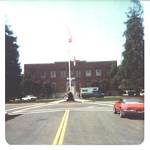 Admin building |
 Bravo 100's graduation |
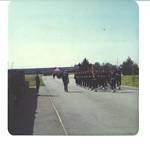 Recruit graduation |
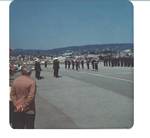 Graduation |
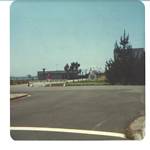 J.O.O.D. Shack |
 Classroom building |
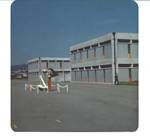 "The Grinder" |
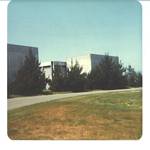 Recruit barracks |
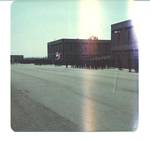 Former Alpha 100 barracks |
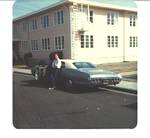 Fred Zachau & his Caprice |
These pictures were taken a few months after I had graduated boot camp and stopped by for a visit. While I was in boot camp I wasn't allowed a camera (or much of anything else!) so these are the only photos I was able to come up with when
this entry was put together 32 years later. The camera was obviously inexpensive and the photos somewhat faded after three decades - nevertheless I think these ten pictures give you and idea of what the setting was like back then...
Back in the 1970s, like half of all Coast Guard recruits, my enlistment started out at "TRACEN" (Training Center) Alameda, on Government Island, in the San Francisco Bay area. I believe that most recruits from the western half of the U.S. were assigned to Alameda while the other half went to Cape, May New Jersey. As I created this entry, 32 years after my boot camp experience, I did a quick check and learned that all Coast Guard recruits (both male and female) are now assigned to Cape May. So, my story will probably be a bit different from most "Coasties" as I went through boot camp and at facility that not longer trains recruits and may not even be in existence anymore...First a disclaimer: Although I found Coast Guard boot camp to be difficult this entry is not meant to be a complaint about the experience nor an indictment against any of the instructors or methods. I entered boot camp (January, 1975) at a difficult time in both my own history and that of our country - the Vietnam War was winding down and I, myself, had had a few differences of opinion about fast cars with the local police in my hometown. So, a tough couple of months in boot camp was good for me and good for a country with various military problems at the time...
My "company," during Coast Guard boot camp, was Alpha 100 - the first triple digit designation in what was basically a sequential ordering of all previous companies before us. Although I'm sure there were a few gaps in the numbering assignments the companies before me were units like, "Alpha 79," "Oscar 86," and "Yankee 95." I believe "Zulu" companies were reserved for those with disciplinary problems, health issues, or other reasons for having to fall out of formation with their regular units. Either way, you get the idea - boot camp training companies, at least on Government Island in California, were numbered in alphabetical and numerical sequence as time went along - you could kind of tell when somebody had went through boot camp if they were able to recall their unit's name (who could ever forget such a thing!!??).
Anyway, like I said, it was a pretty darn rigorous course of training - very little sleep, lots of exercise, and tons of videos, classroom training, and field exercises. For example, we were introduced to the Navy's wonderful (yes, I really mean that!) fire fighting school where they'd dump a few hundred pounds of diesel fuel on a cement representation of a ship's focsal (I believe focsal, or forecastle, is kind of the area of exposed deck and compartments behind the bow...). Wearing protective gear and dragging large fire hoses we recruits would rush in, after lots of training, and put out all kinds of intentional fires that were set to simulate emergency conditions at sea.
For me, back then, sleep was a problem throughout boot camp - I never got enough of it! Although bedtime was relatively early Reveille (Reveille is the bugle, or similar "music," that's used to wake American military personnel all around the world each morning) was very early, sometime around dawn, requiring scrambling, running, exercises, and all kinds of stuff I should now be doing in old age! Even with an early reveille we still had to get up at 2 or 3 in the morning for "rack races," "high-porting," or other forms of punishment for serious infractions or failures from the previous day. Rack races required that you and a bunk mate each pick up a bunk bed, in the middle of the night, and marched with it out on the "Grinder" (parade ground). High-porting was jogging around the parade ground, in unison, shouting "Up, down, in, out" while simultaneously thrusting your AR-15/M-16, in sync, with each yell - I've never experienced anything so exhausting in my life!
Something that was helpful for me were the countless pushup we undertook each and every day. At first they were very difficult but after you've completed a few hundred, during the first week or so, they become relatively easy. Of course the first and last things out of our mouths were, "Sir, sir, sir!" so when you did pushups you had to count out loud, in unison, as "Sir one sir," "Sir two sir," "Sir three sir," etc., usually in sets of 25. And as an added bonus the entire company would have to drop and do 25 pushup anytime and officer crossed our path. And, since the Coast Guard was so small, and had so few officers, they lowered the cross-your-path-pushup-requirement to Chief Petty Offices and above! Needless to say, it got to the point were I was easily doing 200 pushup a day when you added in the required ones for the exercise period after Reveille. And, as I said, it's probably amazing to hear but after you start doing one or two hundred pushups a day you begin to get used to 'em - even when you have to lay your AR-15/M-16 rifle across the back of your hands to keep it from touching the ground!!
Other good stuff in boot camp included plentiful, healthy (or at least what they believed to be healthy back then!) food in a clean, orderly environment. Of course like any other military training environment the food lines were lengthy with everybody standing at attention in silence. However, if you had been a good "lad" (yes, they had all kinds of names for us back then, "lads," "ladies," "scumbags," etc.) somebody a little higher up the food chain (so to speak!) could "Zoom" you ahead of the whole line - it was like a gift from the gods! Of course, just like in the movies if you dropped any food or created a problem you could be required to stand on a table or chair shouting, "Sir, I am a scumbag, Sir!" to the entire crowd. As bad as it sounds it was actually humorous at times and something everybody got used to after a day or two in the chow line!
So, here it is, 32 years later, and I'm having trouble remembering a lot of my recruit training experience. But, like I suggested above, there was a lot of good training throughout Coast Guard boot camp. I learned a lot about navigation, maritime issues, law enforcement, firearms, life saving techniques (rescue swimming, first aid, CPR, etc.), knots, history (government, Coast Guard and military), health, behavior, military bearing, and everything else that teenagers and early "20 somethings" needed for a start on an honorable career saving lives and protecting our nation's coastline and fisheries. Yes, Coast Guard boot camp was tough but I'm glad I experienced it and am honored to have served our country!
Additional Boot Camp Notes:
- While I was in boot camp I was able to watch construction of BART (Bay Area Rapid Transit) immediately to the east of our little island in the bay. BART now, of course, is a huge part of the Bay area's transportation system...
- Speaking of transportation, the Coast Guard provided me with my first helicopter ride - I flew from Denver to San Francisco and a commercial helicopter took me from the international airport over to Oakland where I then found my way to Government Island to stand at attention while waiting in the dark to be admitted...
- Opposite Reveille, Taps (the military call, at night, to extinguish all lights or used as a postlude to military funerals...), were played for us every night throughout boot camp. Our trumpeter, affectionately known as "Mex," (I'll post his name here if I can ever recall it again), skillfully played Taps for us, every night, in addition to some popular favorites (like Albert's Lonely Bull) that we all enjoyed going to sleep by...
- In addition to the AR-15/M-16 we also trained on the "Government" 45 caliber pistol, the .50 caliber machine gun, and the M-1 Garand (I believe it was the M-1 - I don't recall, exactly, because it was the one we used for ceremonial and drill purposes - I don't believe we actually ever fired it...)
- Yes, in Coast Guard boot camp we were quizzed about our General Order (General Orders for Sentries is the official title of a set of rules governing guard duty in the United States military) and Chain-of-Command while on watch during the middle of the night. However, folks from other military branches will be surprised to learn that my Chain-of-Command didn't go through the Department of Defense - nope, William T. Coleman, Jr., secretary of Transportation, held that spot for all of us in the Coast Guard back then!
- While I was in boot camp none of us were allowed to leave Government Island. I mention that because we heard rumor, at the time, that other services (maybe the Army and Air Force?) allowed their recruits limited leave away from the base on weekends. And, of course, our boot camp had no women recruits - women were sent to the Cape May, New Jersey boot camp back then...
In July 2010, John Flores, of Albuquerque,
wrote me about his TRACEN bootcamp experience in the 70s:
Note: In addition to this letter and picture,John gave me permission to post a few pix and a detailed
Note: report about his boot camp experience on my Coast Guard Photos page - thanks John!


|
Click Here for the International Morse code alphabet and phonetics |

|
Click Here for "Q" and "Z" signals |

|
Click Here for my tribute to Morse telegraphy |
Braggin' Rights:
Who holds the Coast Guard's record for receiving Morse code? - ME!Coast Guard 40 wpm certificate.
Armed Forces Day 25 wpm certificate.
ARRL 20 wpm certificate.
Ex - WN6CDA, at age 14, 1970
Ex - KH6JDO, Wahiawa, Oahu 1976
Amateur Extra Class license since June 1982
General Radiotelephone license since August 1990
Restricted Radiotelephone Operator Permit since 1995
WN6CDA circa 1971
(I learned the code at age 14
by memorizing it out of a dictionary!)
WBØJNR circa 2012
40 years later wearing an
ORARI (Indonesia) radio club shirt!Click on this hand key to hear real Morse code! (227k .wav file)
Coast Guard Speed Key Certificate Front
Coast Guard Speed Key Certificate Back
|
|
Click Here to download and hear a 4mb MP3 audio clip about a Coast Guard "iron turnings" rescue mission I was involved in. This clip is from a commercial radio station broadcast on September 1st, 2001. Boulder, Colorado station KVCU (1190 AM) interviewed various members of the Colorado QRP Club and broadcast our stories on their Saturday Morning "Hangover Brunch" program... |
|
|
Click Here to download and hear a 4mb MP3 audio clip about the USS Enterprise. Author Barrett Tillman was a guest on the Mike Rosen show January 9th, 2013 to talk about his recent Weekly Standard article about the USS Enterprise's final voyage in 2012.I called into the show to mention my own experience as a brief visitor aborad "Big E" and asked the guest to describe how huge a vessel it actually was. |

ZUT - Coast Guard CW Operators Association
(I was a member from 1999 to 2004) https://www.cgcwoa.org/

Coast Guard Related Links:
 World War II Coast Guard Poster |
|

Other Related Links:
|
|

 Back to Roger J. Wendell's Home Page...
Back to Roger J. Wendell's Home Page...
Abbey |
About |
Blog |
Contacting
Me |
Copyright |
Disclaimer |
Donate |
Guest
Book |
Home |
Links |
Site
Index |
Solutions |
Terms,
Conditions
and
Fair
Use |
What's
Changed
or
New?
Copyright
© 1955 -